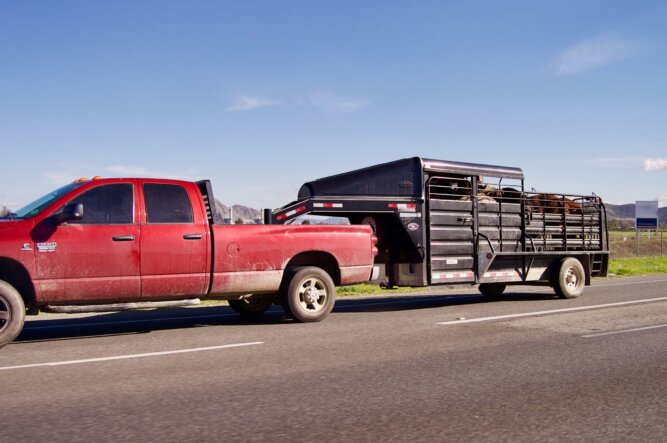Negotiating the Best Hot Shot Rates Per Mile

Get better rates on every deal.
Rate against hundreds of thousands
of daily loads and one million power units.
Hot shot trucking involves delivering time-sensitive, expedited loads for a single customer. Originally rooted in the Texas oil fields, where truckers quickly transported essential parts, this delivery method has evolved to include freight like construction and industrial equipment. Hot shot truckers typically use medium-duty trucks, ranging from 3/4-ton to 1.5-ton capacity, equipped with various hitches and load-balancing trailers to accommodate diverse loads.
Hot shot rates vary significantly based on location, freight type, and urgency. Here’s a quick guide to help you set competitive hot shot trucking rates for your business.
Understanding hot shot rates
To set the best rates, you’ll want to understand how hot shot trucking prices are usually calculated and how much hot shot loads typically pay per mile. Then, you can consider expenses, fuel costs, the type of load, and other factors.
How are hot shot trucking prices calculated?
Hot shot truckers are often quoted a flat rate for delivery. To determine the rate per mile, divide the flat rate by the miles the trip will take. In general, they pay well since they are last-minute, time-sensitive loads. However, the specific hot shot rate you get will depend on your equipment, the size and type of load, and your geographic area.
How much do hot shot loads pay per mile?
Hot shot load rates vary widely, depending on the driver, the load, the shipper, and the urgency of the cargo. A hot shot rate sheet may also have lower rates for freight considered partial loads or any shipment that doesn’t fill an entire trailer or truckload.
Hot shot hauling rates are generally $1.50 per mile. While not common, some jobs, especially urgent ones, will pay as much as $2 per mile. High rates are balanced with the typical minimum of $1 to $1.25 per mile.
A good starting point to negotiate better freight rates is around $1.50 unless you know the broker or shipper is willing to pay more or it’s a specialized load. Know ahead of time what you’re ultimately willing to accept for a haul. Balancing a few well-paying loads with less profitable routes to cover deadhead time can help your business enjoy a steadier profit.
Questions to ask before setting hot shot rates
How do you set hot shot rates and create hot shot rate sheets? First, ask and answer a few key questions:
- Price of expenses: What are your expenses? How much do your truck and trailer cost each month in payments, insurance, and maintenance? Calculate this by dividing your monthly payments and financial obligations by the number of miles you plan to drive per month.
- Fuel costs: What will fuel cost? To get a rough hot shot cost per mile, estimate the average fuel price per gallon you expect to pay and divide it by your average fuel mileage when transporting a load. For instance, if the fuel cost in your region is $2.50 a gallon and your vehicle’s fuel efficiency is 15 miles per gallon, you would calculate the cost per mile by dividing 2.50 by 15, — resulting in about $0.17 per mile.
- Personal payments: How much money do you need to pay yourself? Your salary should cover everything from your mortgage to household costs, childcare, and any other obligations you have. Again, divide this amount by the number of miles you will drive in an average month.
- Type of load: What type of load is it? Hot shot drivers generally get a higher rate for full-truckload, oversized, or hazardous material (HAZMAT) loads and a lower rate for small loads.
- Your home base: Where is your home base? If there are a lot of hot shot truckers in the area, rates will likely go down. You can charge more if there’s high demand and few truckers.
- Type of trip: What does the trip look like? Consider the number of miles and tolls, difficult roads, and other factors that could affect the run.
- The urgency of the shipment: How urgent is the shipment? The hot shot trucking business involves urgency. However, some loads are more urgent than others, and shippers are often willing to pay a premium.
How to set hot shot trucking rates
Setting the correct rates is vital for profitability and long-term success. You can calculate and set the best rates by following these easy steps.
1. Total your expenses.
Start by calculating all your business expenses. These include:
- Truck and trailer payments: Monthly financing costs for your vehicles.
- Insurance: Both for your truck and any necessary cargo insurance.
- Maintenance and repairs: Regular upkeep and unexpected repairs that could arise.
- Fuel costs: Estimated using average fuel consumption and current fuel prices.
- Personal expenses: Your salary must cover living expenses like mortgages, utilities, and other personal obligations.
2. Calculate your base rate.
Once you’ve totaled your expenses, add a percentage for savings in case of emergencies or other unexpected costs. Remember, you want your hot shot business to do more than break even. The total of all expenses, fuel, salary, and savings is the base rate you should charge per mile. Then, consider adding on based on the details about the load and location.
A standard recommendation is adding 10% – 20% of your total expenses to cover emergencies or unexpected costs. That way, your business can handle unforeseen situations while remaining in good financial health. Combine these figures to get the total amount reflecting your operational costs and savings.
3. Determine hot shot price per mile.
To find your rate per mile, divide your total monthly expenses — including savings — by the number of miles you expect to drive in a month. Calculating this will give you a starting point for your hot shot price per mile.
4. Adjust for load and location.
After establishing your base rate, consider other factors that can impact pricing:
- Type of load: Certain loads, such as oversized or HAZMAT, may command higher rates due to their complexity and risk.
- Urgency: If the load is time-sensitive, you can justify charging a premium.
- Location: Rates vary depending on your area and demand. If you’re operating somewhere with high demand and limited truck availability, you might be able to increase your rates.
5. Research local truckload rates.
Once you have this calculation, look up the truckload rates in your area. Do they match what you need to charge? Consider these guidelines to ensure your pricing aligns with market standards:
- Market comparison: Some sources say you should never charge lower than 68% of the local truckload average rate. This ensures you remain competitive while covering your costs.
- Load availability: Are there plenty of loads available in your area? High availability might mean more competition and lower rates, while scarcity will let you charge more.
- Flexibility of delivery: Do the loads have set delivery dates and times, or are they flexible? Flexible loads might allow for better scheduling and potentially higher earnings.
- Load-to-truck ratio: What is the load-to-truck ratio in your area? Low is better, as this gives you leverage to price more aggressively.
6. Negotiate your rates.
Keep in mind that all rates are negotiable. When discussing rates with brokers or shippers, be prepared to justify your pricing based on your calculated expenses, the urgency of the load, and the market conditions. Use data from load boards to support your negotiations and demonstrate your understanding of current market trends.
7. Consider backhauls.
Investigate the outbound load availability in your destination area. Knowing whether there are frequent loads to haul back can significantly reduce deadhead miles and improve your profitability. Use load boards to find return loads that can help cover costs and maximize your earnings on every trip.
Leverage load boards to negotiate the best rates
A load board can help you immensely when it comes to negotiating rates. There are many things you can check using a hot shot load board:
- Check accurate market rates with Rate Insights, a feature of Load Board Pro.
- View >load-to-truck ratios in your area.
- Access historical rate trends for hotshots.
- View broker information — days to pay, credit scores, and more.
- Negotiate the best rates with confidence using the data you’ve gathered.
If you know the rates in your area and what they have been in the past, you’ll understand what brokers and shippers are used to paying. You can also use this information to spot trends — are rates going up or down or staying about the same?
Load boards also help you find loads near your destination so you don’t drive empty. Avoiding deadhead miles is a key to making your trucking business profitable.
Use Truckstop to find hot shot loads
Once you have your rates figured out and what you need to make your business work, use the Truckstop instant booking feature to book loads with brokers you already trust. Book It Now allows you to secure loads outside of regular business hours so you can book when it is most convenient for you. The faster you secure loads, the more time you can spend on the road making money.
No matter where you are with your hot shot trucking business and developing your hot shot rate sheet, Truckstop has the hot shot loads and booking tools you need for your business. Sign up for the Truckstop Load Board today to keep your trucks rolling!

Find out how our platform gives you the visibility you need to get more done.
Get helpful content delivered to your inbox.
Schedule a demo.
Find out how our platform gives you the visibility you need to get more done.





